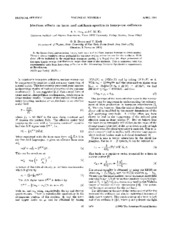| dc.creator | Fang, X. S. | |
| dc.creator | Ko, Che Ming | |
| dc.creator | Brown, G. E. | |
| dc.creator | Koch, V. | |
| dc.date.accessioned | 2011-09-13T21:27:09Z | |
| dc.date.available | 2011-09-13T21:27:09Z | |
| dc.date.issued | 1993 | |
| dc.identifier.citation | X. S. Fang, Che Ming Ko, G. E. Brown and V. Koch. Phys.Rev.C 47 1678-1682 1993. "Copyright (1993) by the American Physical Society." | en |
| dc.identifier.uri | http://dx.doi.org/10.1103/PhysRevC.47.1678 | |
| dc.identifier.uri | https://hdl.handle.net/1969.1/126831 | |
| dc.description | Journals published by the American Physical Society can be found at http://publish.aps.org/ | en |
| dc.description.abstract | In the linear chiral perturbation theory, both kaon and antikaon masses decrease in dense matter. There is also a repulsive vector potential for the kaon and an attractive one for the antikaon. With these effects included in the relativistic transport model, it is found that the slope parameter of the kaon kinetic energy distribution is larger than that of the antikaon. This is consistent with the experimental data from heavy-ion collisions in the Alternating Gradient Synchrotron experiments at Brookhaven. | en |
| dc.language.iso | en | |
| dc.publisher | American Physical Society | |
| dc.subject | NUCLEAR COLLISIONS | en |
| dc.subject | VLASOV EQUATION | en |
| dc.subject | PION-PRODUCTION | en |
| dc.subject | MATTER | en |
| dc.subject | MODEL | en |
| dc.subject | HOT | en |
| dc.subject | Physics | en |
| dc.title | Medium Effects on Kaon and Antikaon Spectra in Heavy-Ion Collisions | en |
| dc.type | Article | en |
| local.department | Physics and Astronomy | en |


